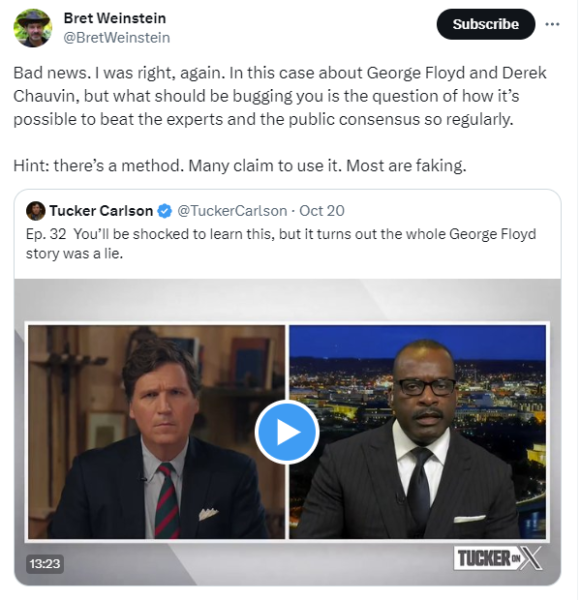On May 25, 2020, George Floyd, a 46-year old Black American man died while being arrested by Derek Chauvin, a 44-year-old White police officer. A trial found Chauvin guilty of murder. The social impact of this case and its outcome has been broad and does not need further explanation. There has been a development.
Now it has come to light in a deposition on a case unrelated to George Floyd that Attorney Amy Sweasy Tamburino—Hennepin County prosecutor—has stated that she had a conversation with Dr Andrew Baker, the medical examiner who performed George Floyd’s autopsy, who stated…
Frankly, whether Floyd died from a fentanyl overdose, physical stress from the pressure applied by the officer, or some combination of factors is something that only God knows. Perhaps it is true that the Floyd “murder” is a lie, and Chauvin has been punished unjustly. I doubt we will ever know the truth for sure.
What about another famous case? On August 9, 2014, an unarmed Black teenager Michael Brown was shot and killed. According to eyewitnesses, Michael Brown raised his hands and said “Don’t Shoot.” Another eyewitness report said the cop fired on Brown—who was unarmed—as he tried to run away. It is worth noting that cops are not supposed to shoot to kill for someone who isn’t a threat (e.g. running away). Police say that Brown charged the police in a threatening way. Obviously if he turned around and charged the officer after being shot from behind while posing no imminent threat, this would change the narrative quite significantly, so it’s important to confirm or rule out that witness testimony. For that, we have to look at the autopsy report.
Here is the autopsy report for the three shots to the arm:

The shot that is most interesting is that last one. This is the upper-most shot on the right arm, as in this picture:

Notice that on an autopsy, the “front” of the upper arm is determined when the arms are in the position shown. If you are in that pose and relax your arms to return your hands to your side, the spot where the bullet entered twists back towards the body and is not directly exposed from the front. In that position, a bullet entering from the front would likely enter the bicep and hit the bone, but as the autopsy report notes, the bullet entered the soft tissue area and exited out of the rear without hitting the bone. Thus, the entry wound was to the left side of the bicep near the edge of the arm next to the armpit.
Put a blot of ink on that spot while in the position shown on the picture and another blot of ink directly behind it on the back of your arm (without intersecting the bone), then relax your arms. Now put your body and arms in various poses and come up with a plausible explanation for how a bullet could go in the that spot (near the armpit) of the upper arm and exit out the other side. Keep in mind that the Brown and the cop are some tens of feet apart from each other and the official narrative is that Brown was facing the officer the whole time until he toppled forward dead after charging at him in a full-out sprint.
What are the plausible scenarios? Do they fit the official scenario or the witness testimony better?
Obviously if Brown were shot from the front while in the submissive pose shown in the diagram, that would explain the wound. But no eyewitnesses report this. This is not the pose one takes when charging at someone at a full run.
Brown could have been shot from the side—his body facing 90 degrees away from the officer to the right side—with his right upper arm fully extended in front of his body and his left arm not blocking the shot. I’m not aware of any eyewitnesses who report this, and that would indicate that Brown was shot while not facing or approaching the officer (i.e. not a threat).
Brown could have been shot through the front of the arm if his hands were raised up in the pose of surrender. This is what some eyewitnesses report (remember “Hands up, don’t shoot“?), but the official report denies that this happened. If this is scenario is true, the officer lied.
Another possibility is that Brown’s arms were down at his side and he was facing away from the officer with his palms facing behind him. A shot from behind would cause this type of wound. Some eye witnesses reports suggest that Brown tried to run away and was shot from behind. The official report denies that this happened. If this scenario is true, the officer lied.
There are also some poses where the upper arm is pointed outward away from the body where it is possible that he could have been shot while facing forward. I don’t believe I’ve seen any witness testimonies or scenario descriptions that are compatible with this possibility, especially if he was sprinting towards the straight towards officer as an active threat.
That’s it. I can’t think of any other explanation. Did I miss any? Is there an error in my analysis, due to me not personally being a qualified medical examiner? And it has been nearly a decade, so my memory may contain errors.
Do you find the official narrative plausible? It sure seems that the most plausible explanation is that Brown was either shot from behind or shot with his hands up in the pose of surrender, especially in light of witness testimony. I find it very difficult to understand how the official narrative explains the wound. What do you think?

